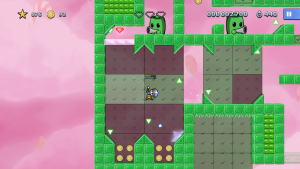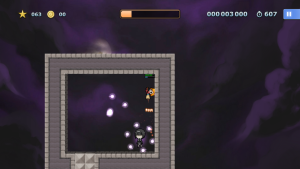Making a game focused around unusual controls is rarely easy and always carries a good amount of risk. If the controls aren’t too different from what players are used to the unique element might feel like it is tacked on to an otherwise generic game, but exceptionally unusual controls may leave most players feeling frustrated or confused and ruin the game as a whole. Miracle Fly walks the thin line between too generic and too unwieldy and results in an experience which feels unique and innovative while still being simple and easy to learn.
Before anything else, I think it needs to be said that, while Miracle Fly has controller and even keyboard support, the most comfortable way to play this game for most people will almost certainly be via a mouse. There is no plot whatsoever to Miracle Fly, but you can choose between three different witches who, as the name of the game suggests, fly through the stages on their brooms (or wands or other magical flying instrument). The main unique mechanic of Miracle Fly is in how attacking and moving are tied together as your attacks are also what move your character around; left clicking will send out a shot towards the mouse cursor and send the character in the opposite direction while right clicking will send a shot out in the opposite direction, thus moving the character in the direction of the cursor. Although holding down a button will allow a character to stay in the air for quite a while, there is a flight meter which can only be refilled when the character is firmly on the ground. As nearly everything in Miracle Fly is tied to a single button, ‘easy to learn, hard to master’ is very much a phrase which applies here; the controls are very simplistic, but multitasking between shooting enemies, paying attention to your character’s position, watching the flight meter, and sometimes trying to avoid shooting certain objects while moving around can quickly become extremely difficult, especially in the later stages.

There are three different characters to choose from before going into a stage and, while they all control in the same basic way, they do have some important differences. Mira has a rapid single-shot attack with low damage and high range, she gains quite a bit of momentum over time while flying, and her flight meter takes a while to completely drain, but she can only heal by finding potions (which become rare after the first few areas) so she tends to be both the most beginner-friendly character and the best character for speedruns. Daria heals upon defeating an enemy and has a mid-range laser which deals very high damage, but it drains her flight meter very quickly and its slow rate of fire can make her difficult to control so she is usually best for boss fights or for stages containing large numbers of tough enemies. Finally, Irvette has a fast, short-range shotgun attack, heals by collecting coins, and has a fairly consistent movement speed. Finishing the game even unlocks new characters to play as which all in turn have different abilities from the original three.
Though the goal of each non-boss level is the same, get to the exit and try to find three hidden gems along the way, there is an astounding amount of variety here. Despite having more than 100 levels, Miracle Fly manages to introduce a new mechanic, enemy, or twist in nearly every level. Stage mechanics start simply enough with pushable or destructible boxes and buttons which will toggle off some walls while making others appear, but things quickly escalate. There are boxes you can manually move around with the mouse while the character stands on a button, objects which rotate with the scroll wheel, bouncing walls, unkillable ghosts, low gravity areas, stealth sections, no-flying zones, water sections which don’t drain the flight meter, and even large, open areas which horizontally wrap as well as more than a few other mechanics and hazards. The sheer amount of variety present here goes beyond merely impressive and, even more so than the unique controls, is what makes Miracle Fly such an outstanding game.

A large part of what allows for this degree of variety is the way in which Miracle Fly divides up its world. The game is technically divided into nine areas, each of which has nine normal levels, a boss level, and three side levels which require red gems to unlock. However, these areas are not neatly divided into thematic sections and instead are intertwined across a large world consisting of well over twenty distinctive regions, each of which has a unique hazard or mechanic. Furthermore, though the standard levels in an area may be labelled one through nine, the actual path through the world has many branches and side areas which often allow you to move out of a region after only one or two levels or to move on to the next area while ignoring a large number of the levels – even several of the boss fights can be entirely skipped by taking alternate paths. The level layout presents a degree of freedom of choice and variety reminiscent of Super Mario World and it can easily take over a dozen hours simply to unlock all of the stages and significantly longer to actually complete every stage and to obtain every optional gem along the way.
Miracle Fly is, in most ways, both highly inventive and polished, but there are a handful of issues to be found. Aesthetically, the game looks great and the enemies and areas radiate charm, but the music could use a bit more variety and it is odd that, in a game which seems designed with mouse control in mind, there is not a custom cursor. I also ran into an issue during my playthrough where the game would freeze up for a split second at regular intervals if I had been playing for an extended period of time, though it is difficult to tell if this was purely some sort of issue on my end as there do not currently seem to be any other reports of this issue. On the mechanical side of things, the timed button gimmick could use some work. Buttons which temporarily open doors are frequently used in Miracle Fly, but there is no way to reset this timer other than letting it run out and then proceeding to press the button once again. While this isn’t much of an issue when the timer is somewhere around give seconds, later parts of the game can have timers which last twenty seconds or more and there seems to be no reason to force players to wait until the countdown ends before it can be reset.

Make no mistake, despite its handful of flaws Miracle Fly is an exceptional game, possibly even one of the best games of 2015. While the high levels of innovation and polish are impressive on their own, it is the sheer, astounding amount of well-implemented variety found between the many stages of Miracle Fly which makes it truly stand out. Too often a large amount of content amounts to little more than tedious, repetitive padding while quality content often comes at the price of the game itself being painfully short. Not only is Miracle Fly entertaining from start to finish, but it balances its high amount of quality with an equally high amount of quantity, making it more than easily worth recommending, especially at its rather modest price.